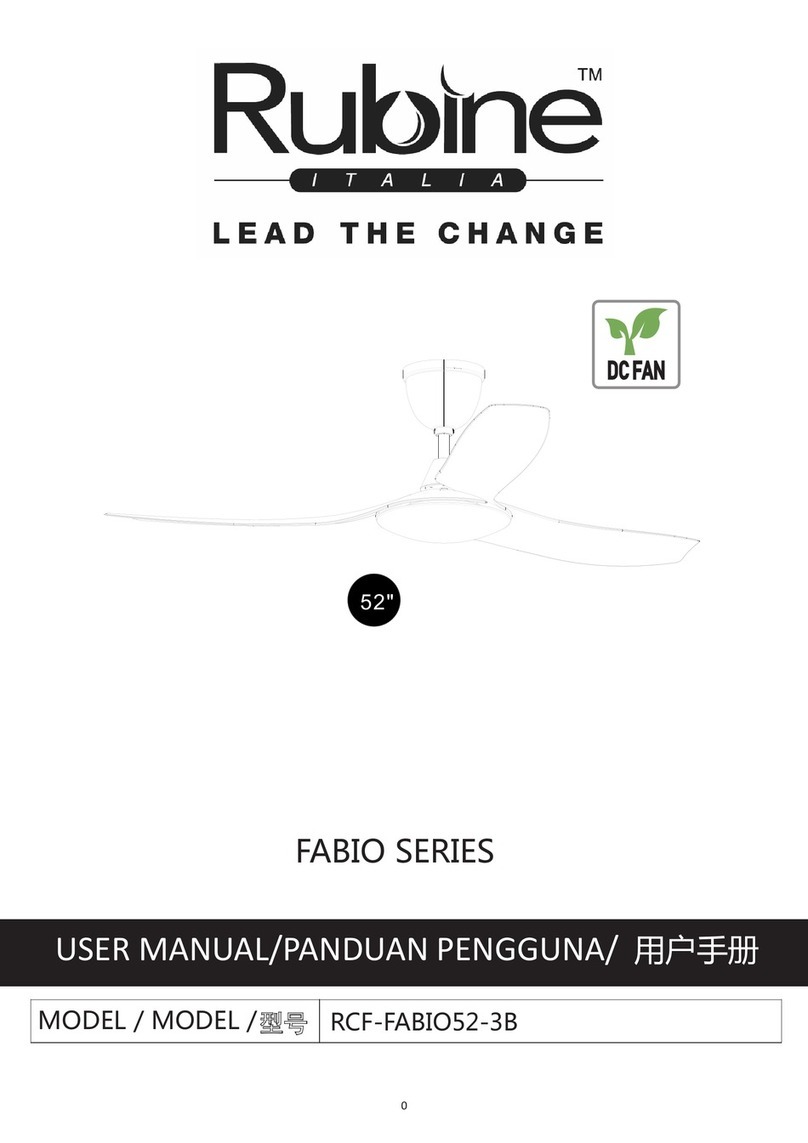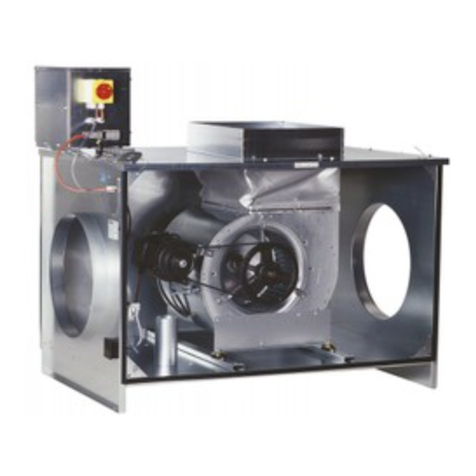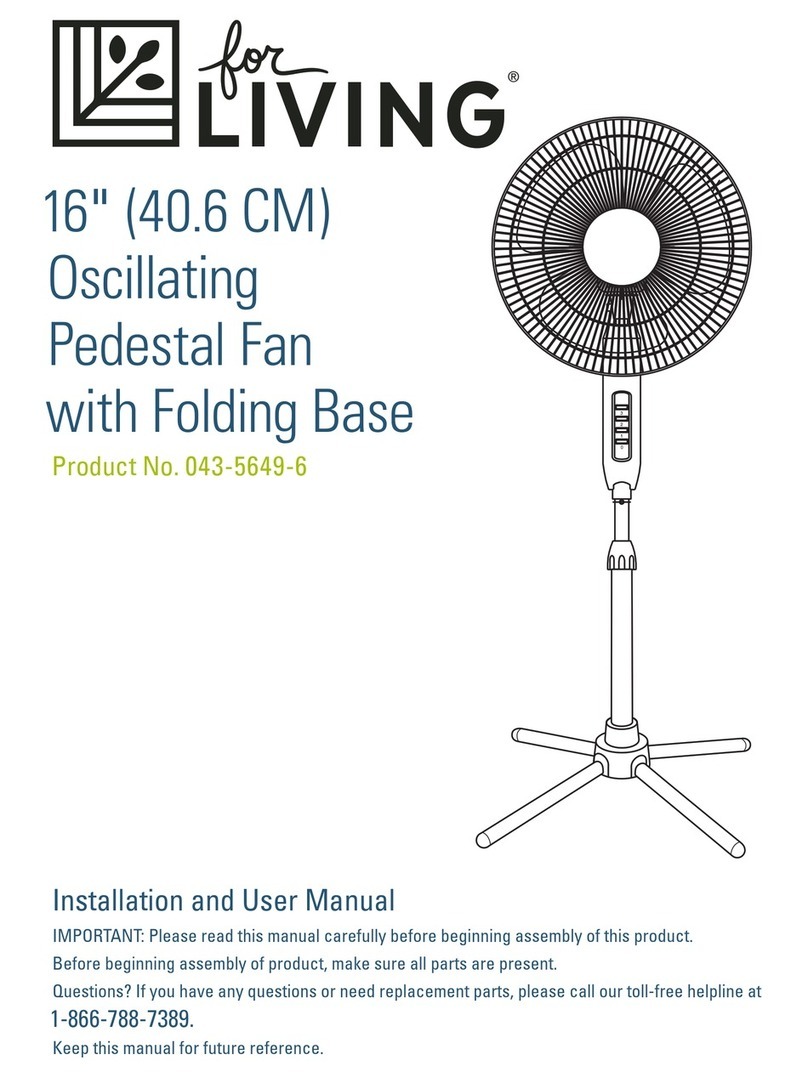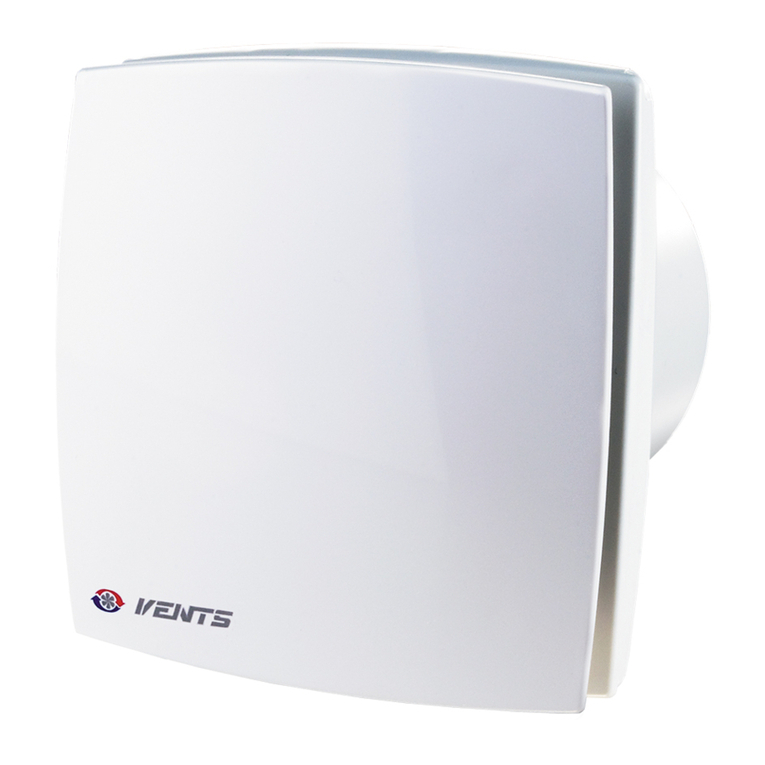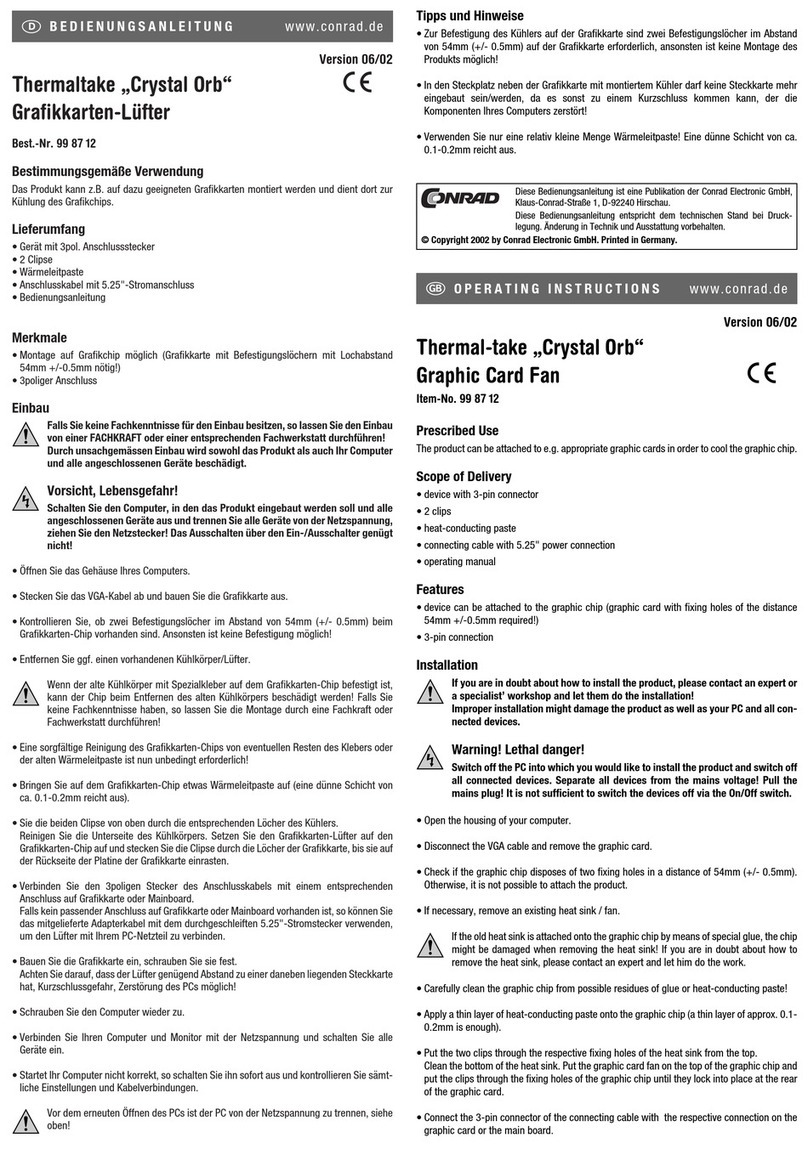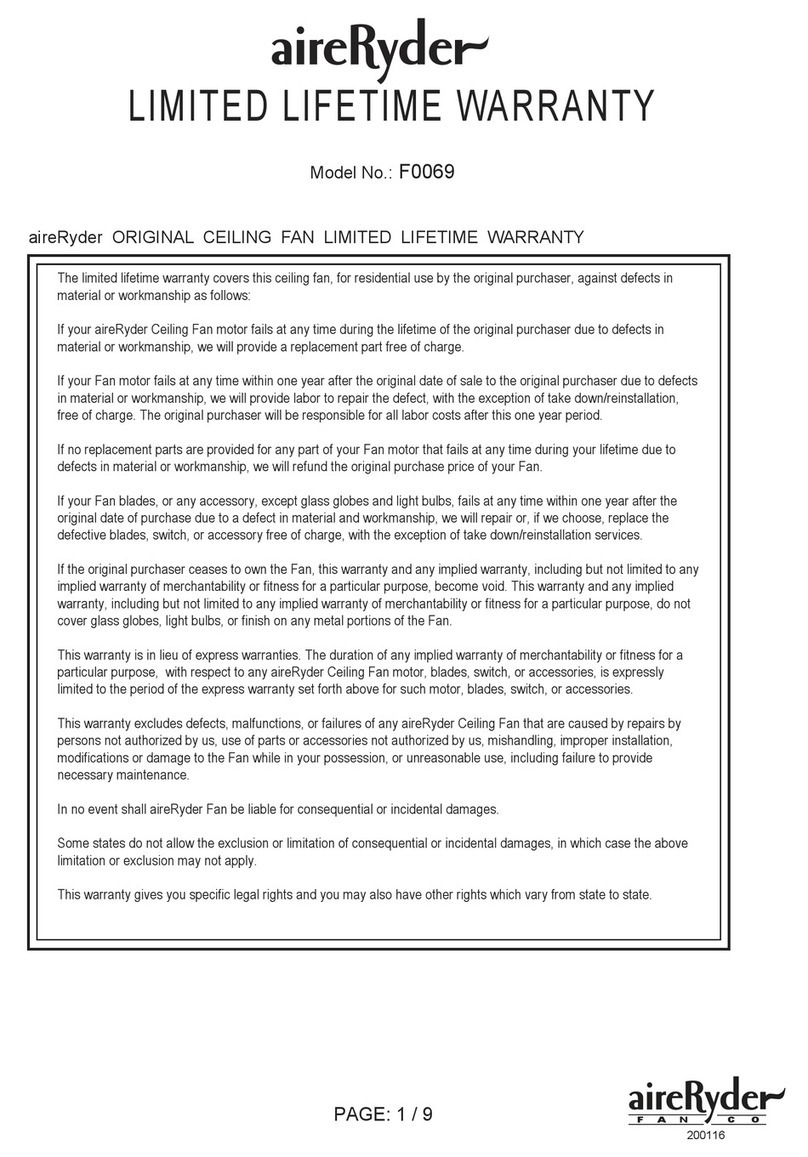Mitsubishi Lossnay LGH-150RVXT-E User manual

Warning:
Repair work must be performed by the manufacturer, its service
agent or a similarly qualified person in order to avoid hazards.
LOSSNAY
HANDBOOK
March 2016 No. U213
MODELS
LGH-150RVXT-E
LGH-200RVXT-E
LGH-250RVXT-E
Remote controller (Optional)
PZ-61DR-E
Nameplate
Filter (Optional)
PZ-150RTF-E
PZ-250RTF-E

Contents
1. Safety precautions ....................................................................... 3
2. Specifications ............................................................................... 4
3. Outside dimensions...................................................................... 5
4. Electrical wiring diagrams ......................................................... 6-7
5. Circuit board diagrams ............................................................. 8-9
6. Troubleshooting .................................................................... 10-34
7. Overhauling procedures
....................................................... 35-51
8. Parts catalog
........................................................................ 52-82
LGH-150RVXT-E ............................................................ 53-62
LGH-200RVXT-E ............................................................ 63-72
LGH-250RVXT-E ............................................................ 73-82

─3 ─
Read the following precautions thoroughly before the maintenance, and then inspect and repair the product in a
safe manner.
The types and levels of danger that may arise if the product is handled incorrectly are described with the warning
symbols shown below.
Warning
Modification is prohibited
Do not modify the unit.
(Failure to heed this warning may result
in electric shock, fire and/or injury.)
Electric shock
If you must inspect the circuitry while the power is
on, do not touch the live parts.
(Failure to heed this warning may result
in electric shock.)
Check insulation
Upon completing repair work, always measure the
insulation resistance. Verify that it is at least 10 MΩ
(with a 500-V DC insulation resistance tester), and
then turn on the power.
(Inadequate insulation may result in
electric shock.)
Incorrect handling of the product may
result in serious injury or death.
Caution Incorrect handling of the product may result in injury or
damage to properties including buildings and equipment.
Proper electric work
Use the electric wires designated for electric work,
and conduct electric work in accordance with your
local "Electric Installation Engineering Standard",
the "Indoor Wiring Regulations" and the installation
instructions.
(Improper connection or wiring installation
may result in electric shock and/or fire.)
Replace damaged and/or degraded parts
Be sure to replace the power cord and lead wires if
they are damaged and/or degraded.
(Failure to heed this warning may result
in electric shock and/or fire.)
Use proper parts and tools
For repair, be sure to use the parts listed in the
service parts catalog of the applicable model and
use the proper tools.
(Failure to heed this warning may result in
electric shock, fire and/or injury.)
Caution against
electric shock
Prohibited
Be sure to follow
this instruction.
Turn off the power supply
Be sure to shut off the power supply isolator before
disassembling the unit for repair.
(Failure to heed this warning may result
in electric shock.)
Make sure that the product operates properly upon completion of repair. Clean the product and the surrounding
area, and then notify the customer of the completion of repair.
Caution for injury
Do not work at a location where you do not have a
sure footing.
(Failure to heed this caution may result in
a fall.)
Notes for servicing
●Inspect the earth condition, and repair it if it is incomplete. Make sure that a power supply isolator or an over-
load protection device is installed, if it is not installed, recommend the customer to install one.
Be sure to follow
this instruction.
Wear gloves
Wear gloves when servicing.
(Failure to heed this caution may result in
injury to your hands from sharp metal or
other edges.)
1. Safety precautions
Be sure to follow
this instruction.
Be sure to follow
this instruction.
Be sure to follow
this instruction.
Be sure to follow
this instruction.
Prohibited

─4 ─
2. Specifications
Model name
Running
current
(A)
Input
power
(W)
Air volume Static pressure Exchange efficiency (%) Noise
(dB)
Weight
(kg)
(m3/h) (L/S) Supply
(Pa)
Exhaust
(Pa)
Temperature
Enthalpy
Heating Cooling
LGH-150RVXT-E 4.3 792 1500 417 175 100 80 70 69 39.5 156
LGH-200RVXT-E 5.4 1000 2000 556 175 100 80 72.5 70 39.5 159
LGH-250RVXT-E 7.6 1446 2500 694 175 100 77 68 65.5 43.0 198
Model name LGH-150RVXT-E, LGH-200RVXT-E, LGH-250RVXT-E
Heat exchange system Heat recovery ventilating system
Heat exchanger material Special treated paper plate heat exchanger
Cladding Galvanized steel sheet
Heat insulation material Self-extinguishing urethane foam
Motor EC motor
Filter Non-woven fabrics filter (Gravitational method 82% EU-G3)
Surrounding air condition Shall be between -10°C and 40°C, 80%RH or less
Suction air condition Shall be lower than 40°C, 80%RH
Supply fan operation under low outdoor
temperature
-10°C to -15°C: Intermittent operation 60 min ON, 10 min OFF
-15°C or less: Intermittent operation 55 min OFF, 5 min ON
Function Energy recovery mode/Bypass mode, Fan speed 1, 2, 3, 4
Electrical power supply 220-240 V/50 Hz, 220 V/60 Hz
Insulation resistance 10 MΩor more
Dielectric strength 1500 V AC 1 minute
Model name PZ-61DR-E
Power supply requirement 12 V DC (Supplied from Lossnay unit)
Power consumption 0.3 W
Transmission cable Non polarized 2-wire (0.3 mm2(AWG22) sheathed cable)
Total wiring length 200 m maximum
Number of controllable Lossnay units 15 Lossnay units maximum (Max. 2 remote controllers installable)
Environmental condition Temperature: 0 to 40°C, Humidity: 30% to 90% relative humidity (no condensation)
Size 120 x 120 x 19 mm
Weight 0.25 kg
Color Munsell 1.0Y9.2/0.2
*The above values apply during Heat recovery mode ventilation when the fan speed is set to Fan speed 4 at the rating pressure
loss and 230 V / 50 Hz.
*For the specifications at the other fan speeds, see the spec. sheets.
*The values given in the table for the noise level reflect the levels measured at a position 1.5 meters immediately below the unit
in an anechoic chamber.
*Noise change or increase may occur because of the Bypass-Automatic function or Automatic fan speed change by timer setting
and/or other functions.
*Temperature exchange efficiency (%) are based on winter condition.
*Mitsubishi Electric measures products according to Japan Industrial Standard (JIS B 8628), therefore Q-H curves are meas-
ured by chamber method.
*On-site commissioning measurements by pitot tube method could be as much 20% different from JIS test room conditions. If
the measuring point is close to sources of turbulence like bends, contractions and dampers etc, it is difficult to measure air vol-
ume correctly. A straight duct length more than 10D (D=duct diameter) from the source of turbulence is recommended for cor-
rect measurement. On-site measurement should therefore be measured in accordance with BSRIA guideline (Commissioning
Air System. Application procedures for buildings AG3/89.3(2001))

─5 ─
3. Outside dimensions
LGH-150RVXT-E, LGH-200RVXT-E, LGH-250RVXT-E
58
287
945.7 945.7
945.7 945.7
227
132
60
215
440
424
250
500
750
255
75090
750750115 250
560560210
ij258
ij242
OA EA
RA SA
50 1450
116
250
250
1500
1980
(exhaust air
outlet)
Exhaust
Supply
Pipe guide
Air exhaust fan (Outside)
Air exhaust fan (Inside)
(outside air
intake)
Lossnay cores
Flange
Flange
Flange
Control box
Air supply fan (Inside)
Air supply fan (Outside)
(return air) (supply air)
By-pass damper plate
By-pass damper plate
(6-15 X 30 oval)
Power supply
cable opening
:KHQXVLQJijGXFW
Ceiling suspension fixture
RA air filters
OA air filters
Unit (mm)
PZ-61DR-E PZ-150RTF-E, PZ-250RTF-E
A
B
15
Model Air Dimensions
The number of
filters per set
Applicable
Lossnay model
AB
PZ-150RTF-E
Supply
655 290 2 LGH-150RVXT-E
Exhaust
655 250 2
PZ-250RTF-E
Supply
985 290 2 LGH-200RVXT-E
LGH-250RVXT-E
Exhaust
985 250 2
Unit (mm) Unit (mm)
*The appearance varies depending on the model.

─6 ─
4. Electrical wiring diagrams
LGH-150RVXT-E, LGH-200RVXT-E
7
8
9
10
S
A
B
1
2
1
2
N
L
N
PE
L
CN7
CN118
CN119
CN10
CN9
TAB5
TAB1
TH1(OA)
TH2(RA)
TM1
CN19
CN18
CN22
CN5
SA2SA1
SW5
SW2
3
TM2
TB5
TM4
TM3
PZ-
61DR-E
CN26(WH)
CN32(WH)
CN17(RE)
TAB2
CN10
CN9
TAB2 TAB1
CN121
CN21
LED1
LED2
LED4
LED3
X13
X14
X15
LED6
LED6
CN20(GR)
GM
M1
M4
M3
M2
SUPPLY
FAN MOTOR
(Inside)
SUPPLY
FAN MOTOR
(Outside)
REACTOR
REACTOR
EXHAUST
FAN MOTOR
(Inside)
EXHAUST
FAN MOTOR
(Outside)
Bypass monitor or Pre-
heater signal output (*1)
Malfunction monitor
output (*1)
Operation monitor
output (*1)
12 V or
24 V DC
Mr. Slim
(non-polar)
Volt-free
contact
M-NET-
transmission cable
2nd remote controller
(Max. 2 controllers)
2nd Lossnay unit
(Max. 15 units)
(*1)
MAX 240 VAC 1 A MIN 220 V AC 100 mA
24 V DC 1 A 5 V DC 100 mA
Isolator
(Field supply)
POWER SUPPLY
220-240V/ 50Hz
220V/ 60Hz
LINE
FILTER
Shielded Wire
COM
Printed Circuit Board 1
(Power circuit board 1)
Printed Circuit Board 2
(Power circuit board 2)
Printed Circuit Board
for control
(Control circuit board)
Definition of symbols
M1: Motor for supply fan (outside)
M2: Motor for supply fan (inside)
M3: Motor for exhaust fan (inside)
M4: Motor for exhaust fan (outside)
GM: Motor for By-pass damper
TH1: Thermistor for outside air
TH2: Thermistor for return air
SW2,5: Switch (Function selection)
TM1: Terminal block (Power supply)
TM2: Terminal block (External control input)
TM3: Terminal block (Monitor output)
TM4: Terminal block (Transmission cable)
TB5: Terminal block (M-NET Transmission cable)
TAB1, TAB2, (TAB5): Connector (Power supply)
X13: Relay contact
X14: Relay contact
X15: Relay contact
CN5: Connector (Thermistor RA)
CN7: Connector (Motor for By-pass damper)
CN9: Connector (Fan motor)
CN10: Connector (Fan motor)
CN17: Connector (Fan speed 1/2/3/4)
CN18: Connector
CN118: Connector
CN19: Connector
CN119: Connector
CN20: For optional components
CN22: Connector (Thermistor OA)
CN26: Connector
(By-pass, 0 - 10 V DC Fan speed control)
CN32: Connector (Remote control selection)
SA1: Address setting rotary switch (tens digit)
SA2: Address setting rotary switch (ones digit)
LED1, LED2: Inspection indicator lamp
LED3:
Remote controller power supply indicator lamp
LED4, LED6: Power supply indicator lamp
SYMBOL : Terminal block
: Connector on PCB
* TM1, TM2, TM3, TM4, TB5 shown in dotted lines are field work.
* Be sure to connect the earth wire.
* A power supply isolator must be installed.
* Always use an isolator for the main switch power connection.
* Select proper circuit breaker according to the electrical current
shown in the right chart.
Model
LGH-150RVXT-E LGH-200RVXT-E
Maximum current when operating 5.6 A 6.4 A
Inrush current after
power supply turned ON
10 ms 12.1 A
100 ms 6.6 A

─7 ─
LGH-250RVXT-E
7
8
9
10
S
A
B
1
2
1
2
CN7
CN118
CN119
CN10
TAB5
TH1(OA)
TH2(RA)
TM1
CN19
CN18
CN22
CN5
SA2SA1
SW5
SW2
3
TM2
TB5
TM4
TM3
PZ-
61DR-E
CN26(WH)
CN32(WH)
CN17(RE)
CN10
CN9
TAB2 TAB1
CN121
CN21
N
L
N
PE
L
LED1
LED2
LED4
LED3
X13
X14
X15
LED6
LED6
CN20(GR)
M2
M3
CN121
LED6
TAB2 TAB1
CN9
TAB2
TAB1
TAB2
TAB1
CN121
LED6
GM
M1
M4
GM
REACTOR
REACTOR
Bypass monitor or Pre-
heater signal output (*1)
Malfunction monitor
output (*1)
Operation monitor
output (*1)
M-NET-
transmission cable
2nd remote controller
(Max. 2 controllers)
2nd Lossnay unit
(Max. 15 units)
Isolator
(Field supply)
Shielded Wire
COM
Top Right Printed Circuit Board
(EA Inside)
(Top right power circuit board)
Printed Circuit Board for Control
(Control circuit board)
LINE
FILTER
12 V or
24 V DC
Mr. Slim
(non-polar)
Volt-free
contact
POWER SUPPLY
220-240V/ 50Hz
220V/ 60Hz
(*1)
MAX 240 VAC 1 A MIN 220 V AC 100 mA
24 V DC 1 A 5 V DC 100 mA
SUPPLY
FAN MOTOR
(Inside)
SUPPLY
FAN MOTOR
(Outside)
EXHAUST
FAN MOTOR
(Inside)
EXHAUST
FAN MOTOR
(Outside)
Top Left Printed Circuit
Board (EA Outside)
(Top left power circuit board)
Bottom Right Printed
Circuit Board
(SA Inside)
(Bottom right
power circuit board)
Bottom left Printed
Circuit Board
(SA Outside)
(Bottom left
power circuit board)
Definition of symbols
M1: Motor for supply fan (outside)
M2: Motor for supply fan (inside)
M3: Motor for exhaust fan (inside)
M4: Motor for exhaust fan (outside)
GM: Motor for By-pass damper
TH1: Thermistor for outside air
TH2: Thermistor for return air
SW2, 5: Switch (Function selection)
TM1: Terminal block (Power supply)
TM2: Terminal block (External control input)
TM3: Terminal block (Monitor output)
TM4: Terminal block (Transmission cable)
TB5: Terminal block (M-NET Transmission cable)
TAB1, TAB2, TAB5: Connector (Power supply)
X13: Relay contact
X14: Relay contact
X15: Relay contact
CN5: Connector (Thermistor RA)
CN7: Connector (Motor for By-pass damper)
CN9: Connector (Fan motor)
CN10: Connector (Fan motor)
CN17: Connector (Fan speed 1/2/3/4)
CN18: Connector
CN118: Connector
CN19: Connector
CN119: Connector
CN20: For optional components
CN21: Connector
CN121: Connector
CN22: Connector (Thermistor OA)
CN26: Connector
(By-pass, 0 - 10 V DC Fan speed control)
CN32: Connector (Remote control selection)
SA1: Address setting rotary switch (tens digit)
SA2: Address setting rotary switch (ones digit)
LED1, LED2: Inspection indicator lamp
LED3:
Remote controller power supply indicator lamp
LED4, LED6: Power supply indicator lamp
SYMBOL : Terminal block
: Connector on PCB
* TM1, TM2, TM3, TM4, TB5 shown in dotted lines are field work.
* Be sure to connect the earth wire.
* A power supply isolator must be installed.
* Always use an isolator for the main switch power connection.
* Select proper circuit breaker according to the electrical current
shown in the right chart.
Model
LGH-250RVXT-E
Maximum current when operating 10.8 A
Inrush current after
power supply turned ON
10 ms 21.8 A
100 ms 11.9 A

─8 ─
1s digit10s digit
Power circuit board
Fed with power: lit
Not fed with power: unlit
Lot number indication
Remote controller
power supply indicator
(LED3 Green)
Bypass monitor output
Pre-heater output
(Between 7and 0)
During bypass mode or
when the pre-heater is operating: 0 ȍ
During heat recovery mode or
when the pre-heater is stopped:
ȍ
Malfunction monitor output
(Between 8and 0)
Error: 0 ȍ
Normal: ȍ
Operation monitor output
(Between 9and 0)
When Lossnay is operating: 0 ȍ
When Lossnay is stopped:
ȍ
Monitor output
COM
Remote controller
(PZ-61DR-E, etc.)
10 to 13 V DC
M-NET transmission
cable (Power supply
unit, etc.)
M-NET transmission
cable (Shielded)
External control input
Power circuit board
5 V DC (Insulated)
Power for the circuit
12 to 14 V DC
(Insulated)
GND
(Insulated)
Fed with power: lit
Not fed with power: unlit
SA1 SA2 SW6
Address setting
switch
Model selection
switch
SW2
SW5
Function selection
switch
Indication of the
microcomputer
software version
Error indicator
(LED1 Green)
Normal: unlit
Error: blinking
During delay operation: lit
M-NET indicator
(LED2 Red)
Registered: unlit
Not registered: lit
M-NET communication error: blinking
Power supply indicator
for the circuit
(LED4 Red)
Outdoor air (OA)
thermistor
Return air (RA)
thermistor
5. Circuit board diagrams
Circuit board diagram and check points
(1)Control circuit board

─9 ─
(2)Power circuit board
Caution:
The power circuit board is not insulated from the power line (high voltage part), except for the connection part
(CN118,CN119, and CN121) with the control circuit board. Also, even when the power supply is cut off, the
capacitor is charged. Therefore, wait for at least five minutes before starting work.
GND
(Not insulated)
Control circuit
board
12 to 14 V DC
(Insulated)
GND
(Insulated)
14 to 16 V DC
(Not insulated)
Lot number
indication
Short
Supply fan motor (CN10)
Pin No. of the connector
1Power for the motor: 280 to 360 V DC
2Not used
3GND
4Power for motor control: 14 to 16 V DC
5Speed command voltage: 0 to 6 V DC
6Rotational speed pulse
Exhaust fan motor (CN9)
Pin No. of the connector
1Power for the motor: 280 to 360 V DC
2Not used
3Not used
4GND
5Power for motor control: 14 to 16 V DC
6Speed command voltage: 0 to 6 V DC
7Rotational speed pulse
Fed with power: lit
Not fed with power: unlit
Power supply indicator
for motor control
(LED6 Red)
Control circuit
board
Damper motor output
220 to 240 V/50 Hz
220 V/60 Hz
Power supply input
(Reactor)
220 to 240 V/50 Hz
220 V/60 Hz
Fuse
10 A/250 V
Fuse
5 A/250 V

─10 ─
Applicable Device Applicable Model
Lossnay Energy Recovery Ventilator LGH-150RVXT-E, LGH-200RVXT-E, LGH-250RVXT-E
Lossnay Remote Controller PZ-61DR-E, PZ-43SMF-E
No. Preliminary check item Details
1 Product information • Model name of the product
• Serial number of the product, manufacturing lot number of the circuit board
• Microcomputer software version marked on the circuit board
2 Fault status • Fault status (For example, the fan does not operate.)
• Error code display on the remote controller
• Operation setting of the remote controller (ventilation mode setting, fan
speed setting, etc.)
3Frequency of fault occur-
rence
• Frequency of fault occurrence (frequency of date and time of occurrence,
regularity of occurrence, etc.)
• Operating time up to fault occurrence
• Date of start of use, date of fault occurrence
4 Timing of fault occurrence • Remote controller operation performed before fault occurrence
• Operating status, etc.
5 System settings • Function selection switch settings and address setting of the Lossnay unit
• Model name and address setting of the Lossnay remote controller or system
controller, etc.
• Function settings on PZ-61DR-E when PZ-61DR-E is used
6 System drawings • System Configuration
• Wiring
• Record of the Lossnay function setting statuses
6. Troubleshooting
Work precautions
• Before starting the service, the power supply isolator must be turned off. Pay sufficient attention to avoid
electric shock or injury.
•
When removing or touching the cables, circuit boards or other parts, make sure to turn off the power supply isolator.
• Even after the power supply isolator is turned off, the capacitor on the circuit board retains high voltage for a
while. Therefore, before servicing, wait for at least five minutes, and then use a tester to check that the volt-
age has dropped.
• Once the power supply is turned off, be sure to wait for at least five minutes before turning the power back
on again.
•
When servicing, power supply to M-NET must be turned off. Live-line working may cause a circuit board failure.
• When servicing, be sure to reproduce the malfunction two or three times before starting repairs.
• When servicing, always take care to keep proper footing.
• When disconnecting the motor connectors, make sure that the power supply is turned off. Even when the
fan motor is stopped, disconnecting the live-line connectors will cause a motor malfunction.
• When removing the circuit board, always hold it at both ends and remove carefully so as not to apply force
to the surface mounted parts.
• When removing the circuit board, be careful of the metal edges on the board.
• When removing or inserting the connectors for the circuit board, hold the entire housing section. Never pull
on the lead wires.
• If it is thought that there is a circuit board malfunction, check for disconnected wires in the print pattern,
burnt parts or discoloration.
•
If the circuit board is replaced, make sure that the switch settings on the new board are the same as the old board.
• Make sure to connect the power supply wires correctly.
• When carrying out wiring, power supply to M-NET must be turned off, otherwise it will cause a malfunction.
The part names in the texts are standardized with the part names in the parts catalog.
(There are some exceptions.)
6-1 Service flowchart
After checking the check items below, follow the troubleshooting for servicing.

─11 ─
Lossnay does not work after installation is
completed.
Lossnay does not work in trial operation
after installation is completed, or Lossnay
stops working during use.
The remote controller does not work after
installation is completed.
Operations such as ON/OFF, fan speed or
ventilation mode switching are not possi-
ble on the remote controller after installa-
tion is completed.
Lossnay does not work properly after
installation is completed.
• An error code is displayed on the remote
controller.
• LEDs on the circuit board blink or light.
6-2 Check Details
(1) Failure mode 1: Lossnay does not work.
Initial Check Items
Check the following details if Lossnay does not work after installation is completed.
1Power supply
No. Check Item Corrective action
1 Is the main power supply on? Turn the main power supply on.
2 Is the current capacity of the power supply isolator
appropriate?
Use an appropriate power supply isolator.
3 Is the designated cable used for the power supply
cable?
Use the designated cable.
4 Is the specified power supply supplied to the power
supply terminal (TM1)?
220-240 V/50 Hz, 220 V/60 Hz
Supply the designated power supply.
5 Is the power supply cable incorrectly wired, is there
a faulty connection or are screws loose?
Connect the cable securely and correctly, and
tighten the screws firmly.
6 Is there a faulty connection on the power supply
terminals (TM1, TAB1, TAB2, and TAB5)?
Connect the lead wires securely.
7 Is there a faulty connection on the reactor terminals? Connect the lead wires securely.
8 Is the jumper connected to TAB3 and TAB4? Connect the jumper properly.
9 Are the power supply indicator lamps (LED4 and
LED6, red) lit?
Check LEDs6 on all the power circuit boards.
Check the above items.
(1) Failure mode 1: Lossnay does not work.
(2) Failure mode 2: The remote controller does not
work.
(3) Failure mode 3: Operations on the remote con-
troller are not possible.
(4) Failure mode 4:
Lossnay does not work properly.
(5) Failure mode 5: Error code and LED display

─12 ─
No. Check Item Corrective action
1 Are the designated cables used for the remote control-
ler transmission cable and M-NET transmission cable?
(See Table 2-1 and Table 2-2.)
Use the designated transmission cables.
2 Are the designated cables used for the external input/
output signal cable? (See Table 2-3.)
Use the designated cables.
3 Are the transmission cables wired using multicore
cables?
Use the designated transmission cables.
4 Are multiple transmission cables wired in the same pip-
ing duct?
Wire the transmission cable away from one
another.
5 Is the power supply cable wired at least 5 cm away
from transmission cables?
Wire the power supply cable at least 5 cm away
from the transmission cables.
6 Are the transmission cables connected to the desig-
nated terminal block? (See Table 2-1 and Table 2-2.)
Connect the transmission cables to the desig-
nated terminal blocks.
7 Are the transmission cables incorrectly wired, is there a
faulty connection or are screws loose?
Connect the cable securely and correctly, and
tighten the screws firmly.
8 Is the wiring length of the transmission cable within the
regulations? (See Table 2-1 and Table 2-2.)
Wire the cables within the regulations.
9 Does the external input signal match the specifica-
tions? (See Table 2-3.)
Input the signal that matches the specifications.
10 Is the external input signal input to the Lossnay set as
the main Lossnay?
Input the signal to the Lossnay set as the main
Lossnay (SW5-10 ON).
11 Is the function selection for the external output signal
set correctly?
Set the function selection switches (SW2-8, 5-2,
and 5-6) on the circuit board correctly.
Set the function settings (No. 57 and 58) of PZ-
61DR-E correctly.
Cable M-NET transmission cable
Type Shielded cable CVVS, CPEVS
Number of cores 2-core cable
Cable diameter 1.25 mm2to 2.0 mm2
Max. extension 200 m (Note 1)
Total extension 500 m (Note 2)
Terminal block TB5 [A] [B]
Cable PZ-61DR-E or PZ-43SMF-E
transmission cable
Type Sheathed cable
Number of cores 2-core cable
Cable diameter 0. 3 mm2(AWG22)
Total extension 200 m
Terminal block TM4 12
2Transmission cables (remote controller transmission cable, M-NET transmission cable, and external input/
output signal cable)
Table 2-1
M-NET transmission cable specifications
When carrying out wiring, power supply to M-NET must be turned off, otherwise it will cause a malfunction.
(Note 1) Distance from the power supply unit to the furthest unit or system controller
(Note 2) Overall length of the cable between the units and the system controllers
Table 2-2
Remote controller transmission cable specifications

─13 ─
Function Name
Terminal or
connector on
the circuit board
Signal
specifications
Materials Used
Total
extension
External control input
(volt-free contact) TM2 13 Level/pulse
(Note 1)
Single-lead 0.8 to 1.2 mm dia. or
twisted lead 0.5 to 1.5 mm2500 m
External control input
(12 V DC, 24 V DC) TM2 12 Level/pulse
(Note 1)
Single-lead 0.8 to 1.2 mm dia. or
twisted lead 0.5 to 1.5 mm2(Note 2)
Mr. Slim indoor unit control signal TM2 12 Serial signal Slim-Lossnay connection cable
(Accessory parts) 500 m
Remote/local switching CN32 13 Level
(Note 1)
Remote ON/OFF adaptor
(PAC-SE55RA-E)
10 m
Remote ON/OFF input CN32 12
Fan speed 4 input (volt-free contact) CN17 12
Level
(Note 1) Remote display adaptor
(PAC-SA88HA-E)
Fan speed 3 input (volt-free contact) CN17 13
Fan speed 2 input (volt-free contact) CN17 14
Fan speed 1 input (volt-free contact) CN17 15
Bypass mode input
(volt-free contact) CN26 12
Fan speed switching input
(0 to 10 V DC) CN26 45 Analog
Table 2-3 External input/output specifications
<Caution>
• Input the signals to the Lossnay (SW5-10 ON, with the smallest address setting) set as the main Lossnay in
the group.
(Note 1) The input signal must conform to the following specifications:
Level signal Volt-free contact, 12 V DC, 24 V DC, the duration of ON and OFF should be 10-second
or more.
Pulse signal Volt-free contact, 12 V DC, 24 V DC, the duration of ON should be 200 msec. or more,
and minimum 10-second absence is necessary to the next pulse .
In the case of relay contact input, use a relay having a contact rating of 15 V DC/0.1 A or higher and a
minimum applicable load of 1 mA or less.
(Note 2) Check the specifications of the external device.

─14 ─
No. Check Item Corrective action
1 Is the main Lossnay set correctly? Check the function selection switch (SW5-10) on
the circuit board.
When an external signal is input to multiple Lossnay
units, set one of the units in the group as the main
Lossnay (SW5-10 ON).
2 Are the function selection switches on the circuit
board set correctly to suit the required application?
Set the function selection switches (SW2 and SW5)
on the circuit board correctly.
3 Is the applicable model used as the Lossnay re-
mote controller?
Use PZ-61DR-E or PZ-43SMF-E.
(The air conditioner remote controller including
PAR-31MAA cannot be used.)
4 When PZ-61DR-E is used, are the function selec-
tions set correctly to suit the required application?
Set the function selections correctly.
5 Was a function set with the function selection
switches on the circuit board after the function is set
with PZ-61DR-E?
Set the function again with PZ-61DR-E.
For the function that can be set with both PZ-
61DR-E and the function selection switches, if the
function is set to other than "DIP-SW priority" with
PZ-61DR-E, setting with the function selection
switches is disabled.
6 Is the Lossnay address set correctly? Set the address setting switches (SA1 and SA2)
correctly.
4Function setting (See the Lossnay technical manual for details.)
Terminal block TM3 90 TM3 80 TM3 70
Function Name Operation monitor Malfunction monitor Bypass monitor or
Pre-heater
Signal specifications Volt-free contact
Output rating 240 V AC, 1 A
24 V DC, 1 A
Min. applicable load 220 V AC, 100 mA
5 V DC, 100 mA
Table 3-1 Monitor Output Specifications
No. Check Item Corrective action
1 Is the signal cable wired by multicore cable? Wire the cable using a 2-core cable.
2 Are the signal cables and transmission cables wired
in the same piping duct?
Wire the signal cables away from the transmission
cables.
3 Is the power supply cable wired at least 5 cm away
from signal cables?
Wire the power supply cable at least 5 cm away
from the signal cables.
4 Is the signal cable connected to the designated
terminal block? (See Table 3-1.)
Connect the signal cable to the designated terminal
block.
5 Is the signal cable incorrectly wired, is there a faulty
connection or are screws loose?
Connect the cable securely and correctly, and
tighten the screws firmly.
6 Is the output capacity of the signal cable within rat-
ing? (See Table 3-1.)
Use the signal cable within rating.
7 Is the function selection for the external output
signal set correctly?
Set the function selection switches (SW2-8, 5-2,
and 5-6) on the circuit board correctly.
Set the function settings (No. 57 and 58) of PZ-
61DR-E correctly.
(See the Lossnay technical manual.)
3Monitor output signal cable

─15 ─
No. LED Contents Check Item Corrective action
1 LED1
(green)
Lossnay main unit
error indicator
Blinking: Starting up, or error oc-
curred
See Failure Mode 5.
Lit: During delay operation Lossnay operates after the delay time
has passed.
Unlit: Other than above It is normal.
2 LED2
(red)
M-NET System
error indicator
Blinking: Error occurred See Failure Mode 5.
Lit: No M-NET connection informa-
tion
When using M-NET, perform group reg-
istration with the system controller.
Unlit: Other than above It is normal.
3 LED3
(green)
Remote control-
ler power supply
indicator
Lit: Power supplied to the remote
controller (Main Lossnay)
The LED goes out when power is sup-
plied to the remote controller from other
Lossnay units in a multiple Lossnay
group.
Unlit: Power not supplied to the re-
mote controller (Sub Lossnay)
4 LED4
(red)
Power supply
indicator (control
circuit board)
Check that this LED is lit The LED lights while power is being
supplied to the control circuit board.
5 LED6
(red)
Power supply
indicator (power
circuit board)
Check that this LED is lit The LED lights while power is being
supplied to the power circuit board.
(Do not touch components on the circuit
board when the LED is lit.)
5LED Indications on the circuit board

─16 ─
No.
Problem Factor Corrective action
1 The fan does not
operate even
though the trial
operation switch
(SW2-1) on the cir-
cuit board is turned
ON.
The connector between the fan
motor and circuit board is discon-
nected.
Check the connector (CN9) for the exhaust fan
motor and the connector (CN10) for the supply
fan motor.
The connector between the con-
trol circuit board and power circuit
board is disconnected.
Check the connector connections (CN18-CN118,
CN19-CN119, and CN21-CN121).
The wiring for the reactors is
incorrect.
Check the wiring for the reactors.
The jumper is not connected to
TAB3 and TAB4.
Connect the jumper to TAB3 and TAB4.
The model selection switch (SW6)
is not set correctly.
Make the SW6 setting appropriate for the model.
(See chapter 7. (11) Setting status record (page 51).)
The temperature around the prod-
uct is high.
Use the product at a temperature of 40°C or
lower.
Fan motor failure Check the resistance between the motor leads.
(See chapter 6. (7) Motor resistance table (page 34).)
If the measured value is significantly different
from the values specified in the table, replace
the motor.
Circuit board failure Disconnect the connectors (CN9 and CN10),
and check the output voltage of each pin of the
connectors within one minute after turning the
switch (SW2-1) ON. (One minute later, the error
will occur.)
(See chapter 5. (2) Power circuit board (page 9).)
If the voltage value is abnormal, replace the
circuit board.
If the problem persists, replace the motor.
2 Though the remote
controller display
indicates the fan
is running, the fan
stops by itself.
The Lossnay unit is operating in
the protective mode (intermittent
operation).
When PZ-61DR-E is used, it displays the icon
"" that indicates the protective operation is in-
progress. For details, see the Lossnay technical
manual or remote controller manual.
The Lossnay unit is set to the
delay operation.
When PZ-61DR-E is used, it displays the icon
"" that indicates the delay operation is in-
progress.
LED1 (green) on the control circuit board lights.
Lossnay operates in 30 minutes (or 15 minutes)
after the air conditioner is operated to run.
Check the function selection switch (SW5-1) on
the circuit board or the function setting (No. 9) of
PZ-61DR-E. (See the Lossnay technical manual.)
The interlocked air conditioner
(Mr. Slim indoor unit or City Multi
indoor unit) is defrosting.
The supply fan has been stopped to prevent
cold air from blowing out. When the air condi-
tioner finishes defrosting, the fan operation is
started automatically.
The system is switching the venti-
lation mode.
When switching the ventilation mode (Energy
recovery mode/Bypass mode), the fan stops (for
approx. 30 seconds).
The temperature around the prod-
uct is high.
When the ambient temperature of the product
is high (higher than 40°C), the fan may stop to
prevent the fan motor from overheating.
Individual function check items
If Lossnay does not work in the trial operation after installation is completed, or if Lossnay stops working dur-
ing use, check the following items.

─17 ─
No.
Problem Factor Corrective action
3 The fan does not
stop even though
the remote control-
ler is operated to
stop operation.
The pre-heater or operation moni-
tor with delay operation is set to
be used.
If the pre-heater or operation monitor with delay
operation is set to be used, the fan continues op-
erating for three minutes after the stop operation.
Check the function selection switches (SW2-8
and 5-6) on the circuit board or the function set-
tings (No. 57 and 58) of PZ-61DR-E. (See the
Lossnay technical manual.)
4 Even though the
remote controller is
operated to change
the fan speed, the
fan speed does not
change.
The indoor negative pressure
setting or the indoor positive pres-
sure setting is set.
Check the function selection switches (SW2-
4 and 2-5) on the circuit board or the function
settings (No. 6 and 7) of PZ-61DR-E. (See the
Lossnay technical manual.)
The external fan speed input is
set. (CN17)
When PZ-61DR-E is used, it displays the icon " ".
Check the fan speed switching input (CN17).
The external fan speed input is
set. (CN26)
When PZ-61DR-E is used, it displays the icon " ".
Check the function selection switches (SW2-3
and 2-6) on the circuit board or the function set-
ting (No. 63) of PZ-61DR-E. (See the Lossnay
technical manual.)
The system is operating in the
protective mode (intermittent
operation).
When PZ-61DR-E is used, it displays the icon
""that indicates the protective operation is
in-progress.
For details, see the Lossnay technical manual
or remote controller manual.
The pre-heater is ON. When the pre-heater is ON, Lossnay runs at
Fan speed 2 or higher speed. Even when Fan
speed 1 is selected with the remote controller or
external fan speed input, Lossnay runs at Fan
speed 2.
5 The fan operation is
unstable.
The motor rotation speed is under
control.
This product controls the motor by detecting the
motor rotation speed. The fan operation may be
unstable during rotation speed control (for maxi-
mum about 10 minutes).
6 Air volume is abnor-
mally large or small.
The model selection switch (SW6)
is not set correctly after the circuit
board is replaced.
Make the SW6 setting appropriate for the model.
(See chapter 7. (11) Setting status record (page
51).)
7 The damper does
not operate even
though the trial
operation switch
(SW2-1) on the cir-
cuit board is turned
ON.
The connector between the
damper motor and circuit board is
disconnected.
Check the connection of the connector (CN7) on
the power circuit board.
Mechanical failure Remove the rod of the damper board and check
if the damper board can be moved by hand.
Damper motor failure Remove the rod of the damper board and turn
the trial operation switch (SW2-1) ON.
The damper motor operates in about 30 seconds.
If the damper motor does not operate, replace
the GM assembly.
Circuit board failure Disconnect the connector (CN7) from the power
circuit board and check the voltage value be-
tween the pins of CN7 when the trial operation
switch (SW2-1) is turned ON.
(Voltage is output in about 30 seconds after
switch ON.)
If there is no voltage value, replace the circuit
board.
If the problem persists, replace the GM assem-
bly.

─18 ─
No.
Problem Factor Corrective action
8
Even though the
remote controller is
operated to change
the ventilation mode,
the ventilation mode
is not changed.
The outdoor temperature is 8°C
or lower.
When the outdoor temperature is 8°C or lower,
the ventilation mode is fixed to the Energy re-
covery mode.
The signal is input to the Bypass
mode switching input (CN26
12).
Check the Bypass mode switching input (CN26
12). (See the Lossnay technical manual.)
The pre-heater is ON, or within
one hour after the pre-heater is
turned OFF.
When the pre-heater is ON, or for one hour after
the pre-heater is turned OFF, the ventilation
mode is fixed to the Energy recovery mode.
9 The ventilation
mode cannot be
switched when
Lossnay is operat-
ing in the automatic
mode.
Temperature condition for Energy
recovery mode or Bypass mode is
not satisfied.
Check the temperature map.
For details, see the Lossnay technical manual.
It has not passed 30 minutes since
the ventilation mode is switched.
Switching of the ventilation mode is controlled in
30 minutes cycle.
The outdoor temperature is 8°C
or lower.
When the outdoor temperature is 8°C or lower,
the ventilation mode is fixed to the Energy re-
covery mode.
The signal is input to the Bypass
mode switching input (CN26
12).
Check the Bypass mode switching input (CN26
12). (See the Lossnay technical manual.)
The operation mode of the inter-
locked air conditioner (Mr. Slim in-
door unit or City Multi indoor unit)
is set to fan operation or heating.
If the operation mode of the interlocked air
conditioner is fan operation or heating, the ven-
tilation mode of Lossnay is fixed to the Energy
recovery mode.
The pre-heater is ON, or within
one hour after the pre-heater is
turned OFF.
When the pre-heater is ON, or for one hour after
the pre-heater is turned OFF, the ventilation
mode is fixed to the Energy recovery mode.
10 Air volume is too
small.
Is the air filter clogged? Clean the air filter.
Pressure loss in the duct is too
high.
Set the supply/exhaust fan power up setting.
(See the Lossnay technical manual.)
The model selection switch (SW6)
is not set correctly after the circuit
board is replaced.
Make the SW6 setting appropriate for the model.
(See chapter 7. (11) Setting status record (page
51).)
The indoor negative pressure
setting or the indoor positive pres-
sure setting is set.
Check the function selection switches (SW2-
4 and 2-5) on the circuit board or the function
settings (No. 6 and 7) of PZ-61DR-E. (See the
Lossnay technical manual.)
Power supply voltage is low. Check the power supply voltage.
In interlock with the air conditioner,
the outdoor air intake port of the
Lossnay unit is connected with the
air conditioner by using a duct.
In this case, even if the Lossnay remote con-
troller is operated to start Lossnay while the air
conditioner is stopped, Lossnay will not supply
air.

─19 ─
No.
Problem Factor Corrective action
1 Nothing is displayed
on the remote con-
troller.
The ON/OFF lamp
does not blink.
The power of the Lossnay unit is
not ON.
Check the items described in (1) 1.
Faulty connection of the remote
controller transmission cable
Check the items described in (1) 2.
In one group, three or more PZ-
61DR-E controllers are connected.
Only up to two PZ-61DR-E controllers can be
connected in one group.
In one group, 16 or more Lossnay
units are connected.
Only up to 15 Lossnay units can be connected
in one group.
The wiring length of the remote
controller exceeds 200 m.
The wiring length of the remote controller shall
be within 200 m.
In one group, two or more
Lossnay units are set as the main
Lossnay (SW5-10 ON).
Only one Lossnay unit can be set as the main
Lossnay in one group.
2 The remote control-
ler continues to dis-
play "Please Wait".
Error code "6831" is
displayed.
The remote controller is starting
up.
The remote controller displays "Please Wait"
during start-up for maximum four minutes.
Faulty connection of the remote
controller transmission cable
Check the items described in (1) 2.
The remote controller transmis-
sion cable is connected to the
terminal block (TB5 [A] [B]) for the
M-NET transmission cable.
Connect the remote controller transmission
cable to the terminal block (TM4 12).
PZ-43SMF-E is used together. PZ-61DR-E and PZ-43SMF-E cannot be used
together.
3 It takes time for the
remote controller to
be fed with power
after turning the
Lossnay unit ON.
The Lossnay unit is starting up. The remote controller is not fed with power dur-
ing start-up of the Lossnay unit for maximum
one minute.
(2) Failure mode 2: The remote controller does not work.
If the remote controller does not work after installation is completed, check the following items.
1PZ-61DR-E
2PZ-43SMF-E
No.
Problem Factor Corrective action
1 The power indicator
"" is not displayed.
The power of the Lossnay unit is
not ON.
Check the items described in (1) 1.
Faulty connection of the remote
controller transmission cable
Check the items described in (1) 2.
In one group, three or more PZ-
43SMF-E controllers are connected.
Only up to two PZ-43SMF-E controllers can be
connected in one group.
In one group, 16 or more Lossnay
units are connected.
Only up to 15 Lossnay units can be connected
in one group.
The wiring length of the remote
controller exceeds 200 m.
The wiring length of the remote controller shall
be within 200 m.
In one group, two or more
Lossnay units are set as the main
Lossnay (SW5-10 ON).
Only one Lossnay unit can be set as the main
Lossnay in one group.
(See the Lossnay technical manual.)
2
"H0" is displayed on
the remote controller.
The remote controller is starting
up.
The remote controller displays "H0" during start-
up for a maximum of one minute.

─20 ─
No.
Check item Notes
1 Are the function selection switches
(SW2 and SW5) on the Lossnay
circuit board set correctly to suit the
required application?
Depending on the settings of the function selection switches,
Lossnay may automatically operate or stop, or specific operation
may be unable to be performed with the remote controller.
2 When PZ-61DR-E is used, are the
function selections set correctly to
suit the required application?
Depending on the settings of the function selections, Lossnay may
automatically operate or stop, or specific operation may be unable
to be performed with the remote controller.
3 When PZ-61DR-E is used, are icons
and characters displayed on the PZ-
61DR-E screen?
Based on the icon and characters, you can check statuses such
as the timer operation, Night-purge, and protective operation.
(See the Lossnay technical manual.)
4 Is the system controller of M-NET
used?
The system controller can be used to start/stop Lossnay, change
fan speed or ventilation mode, and prohibit the start/stop operation
by PZ-61DR-E.
5 Is the external input used? If the interlock mode is set to the "External input priority ON/OFF
interlock" and if the external device is operating, the stop operation
by PZ-61DR-E is prohibited. (See the Lossnay technical manual.)
If the Remote/Local switching (CN32) is set to remote, the start/
stop operation by the Lossnay remote controller is prohibited.
(See the Lossnay technical manual.)
Priority is given to the operation by the fan speed switching input
and Bypass mode switching input. (CN17, CN26)
(See the Lossnay technical manual.)
(3) Failure mode 3: Operations on the remote controller are not possible.
Initial Check Items
If the system cannot be operated with the remote controller after installation is completed, check the following items.
No.
Problem Factor Corrective action
3 It takes time for the
remote controller to
be fed with power
after turning the
Lossnay unit ON.
The Lossnay unit is starting up. The remote controller is not fed with power dur-
ing start-up of the Lossnay unit for a maximum
of one minute.
4 The inspection
number "6801" is
displayed on the
remote controller.
Faulty connection of the remote
controller transmission cable
Check the items described in (1) 2.
The remote controller transmis-
sion cable is connected to the
terminal block (TB5 [A] [B]) for the
M-NET transmission cable.
Connect the remote controller transmission
cable to the terminal block (TM4 12).
PZ-61DR-E is used together. PZ-43SMF-E and PZ-61DR-E cannot be used
together.
This manual suits for next models
5
Table of contents
Other Mitsubishi Fan manuals

Mitsubishi
Mitsubishi VL-220CZGV-E User manual
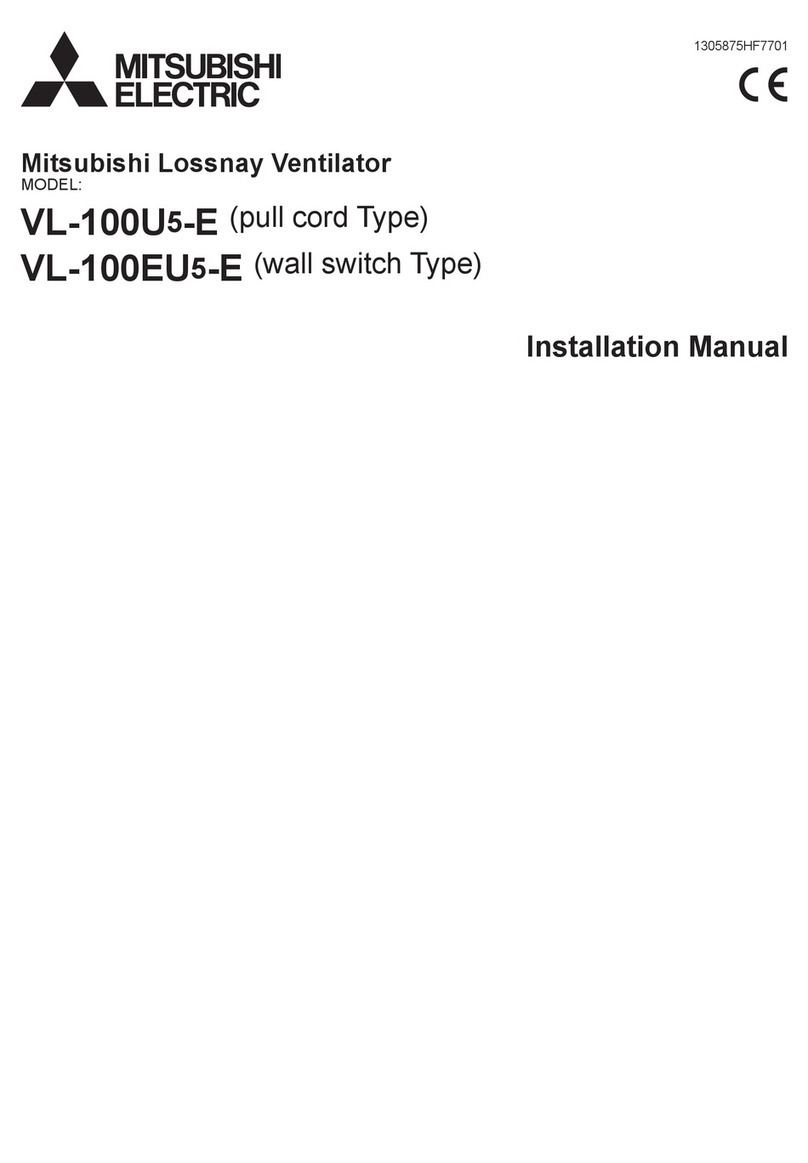
Mitsubishi
Mitsubishi VL-100U5-E User manual
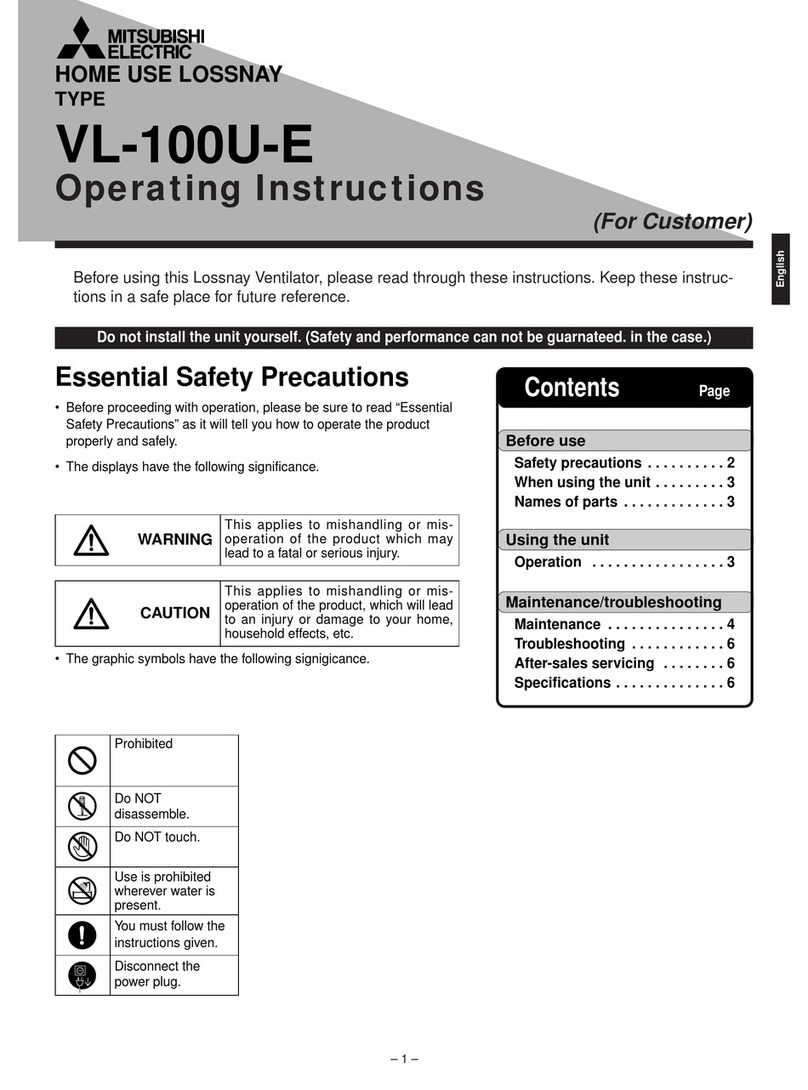
Mitsubishi
Mitsubishi Lossnay VL-100U-E User manual
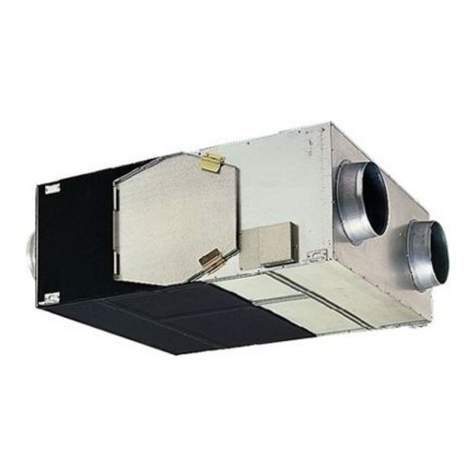
Mitsubishi
Mitsubishi LGH-15RX5-E User manual
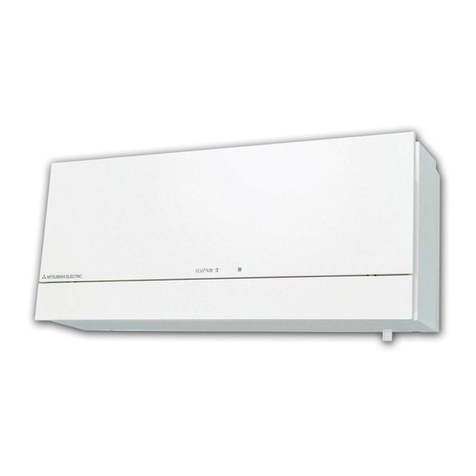
Mitsubishi
Mitsubishi VL-100EU5-E User manual
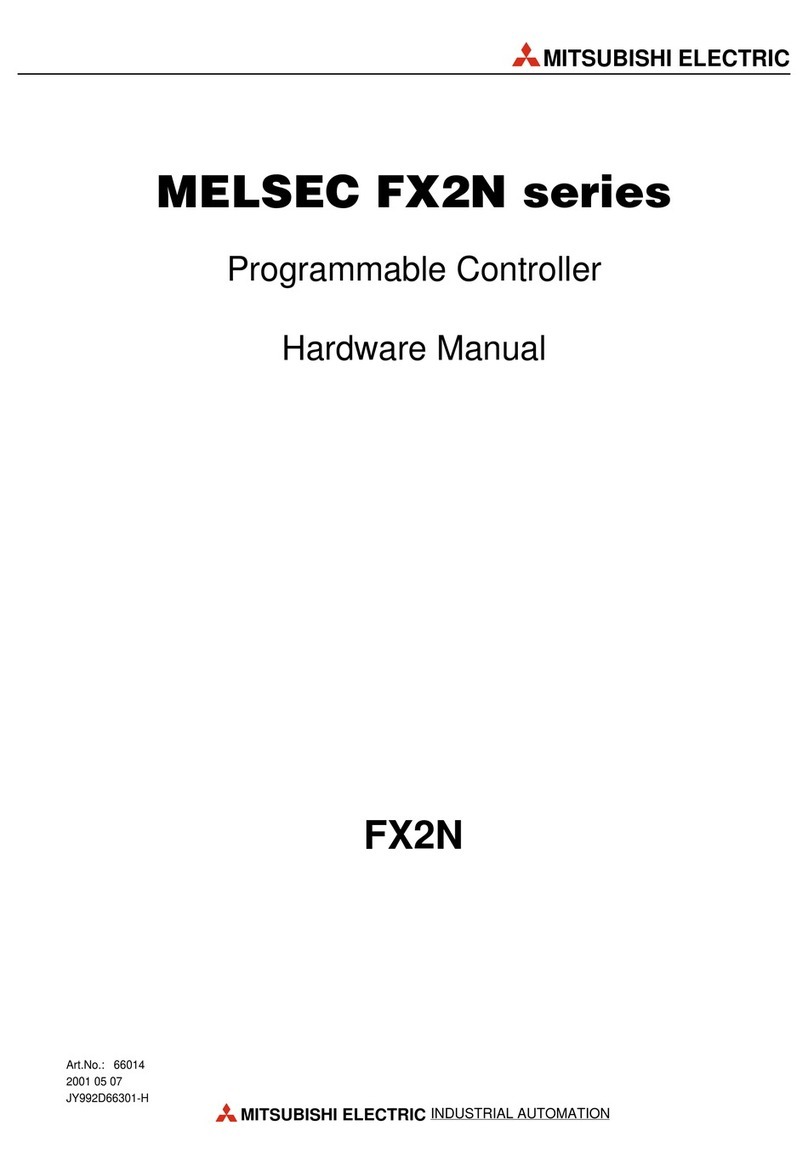
Mitsubishi
Mitsubishi FX2N User manual
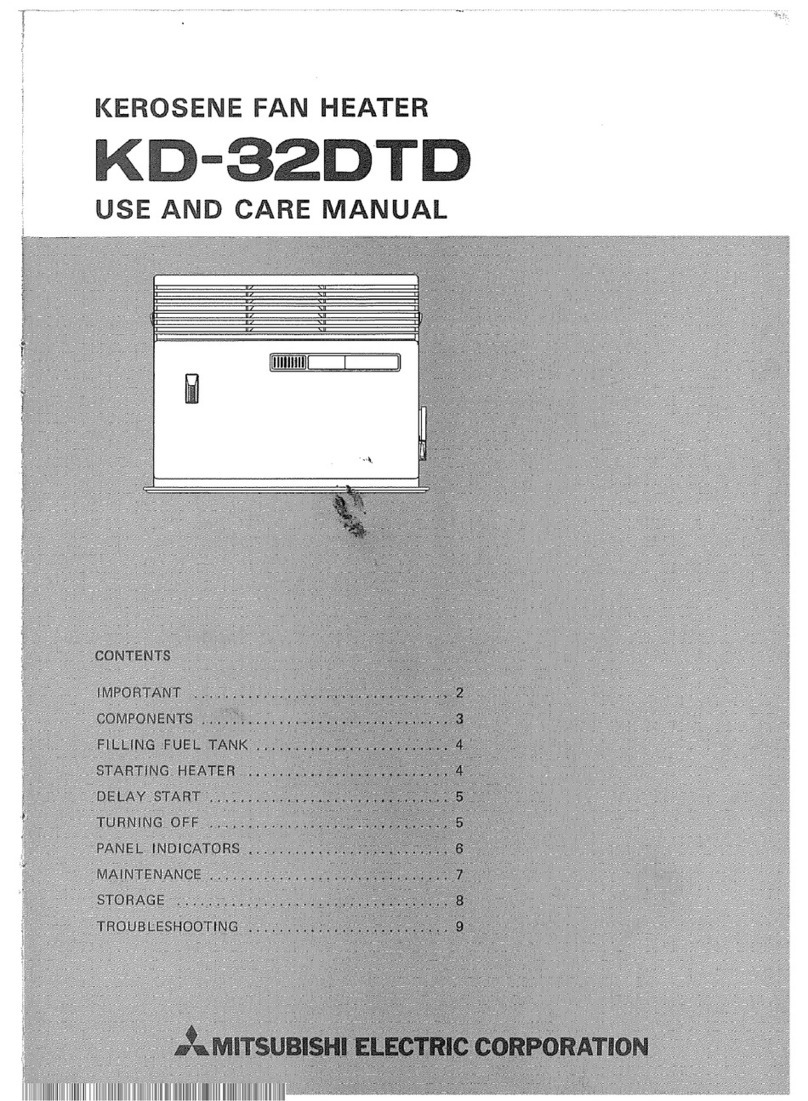
Mitsubishi
Mitsubishi KD-32DTD User manual
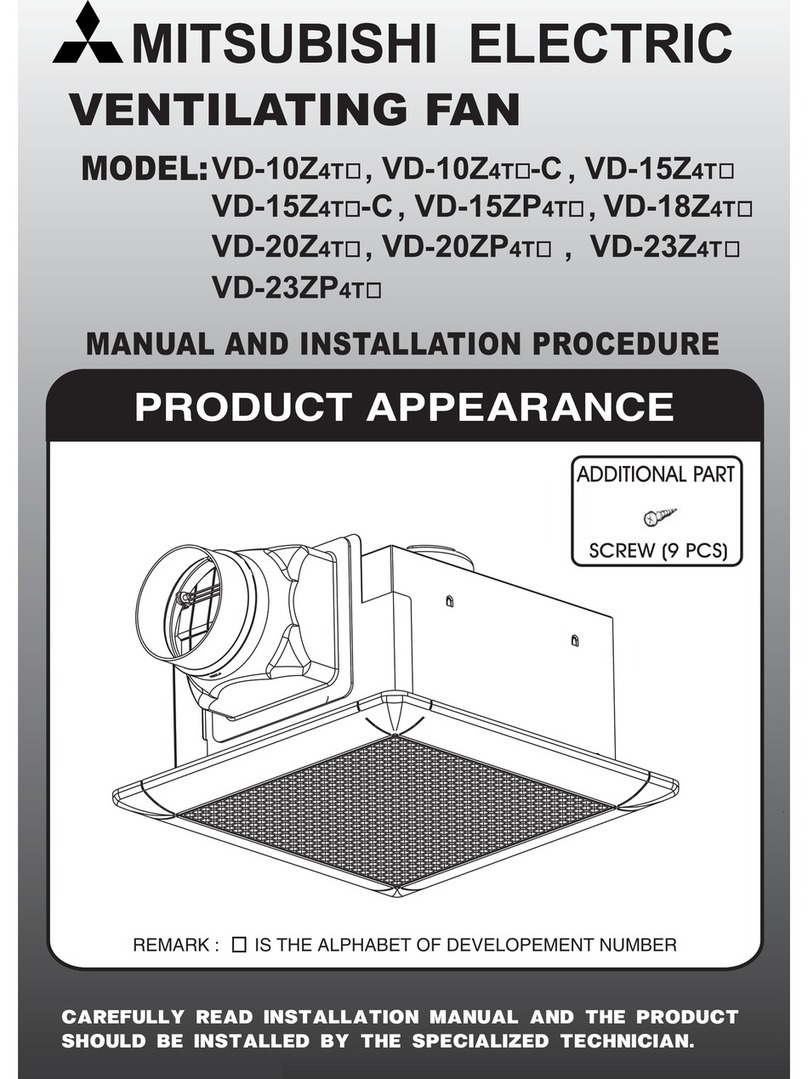
Mitsubishi
Mitsubishi VD-10Z4T Safety guide
Popular Fan manuals by other brands
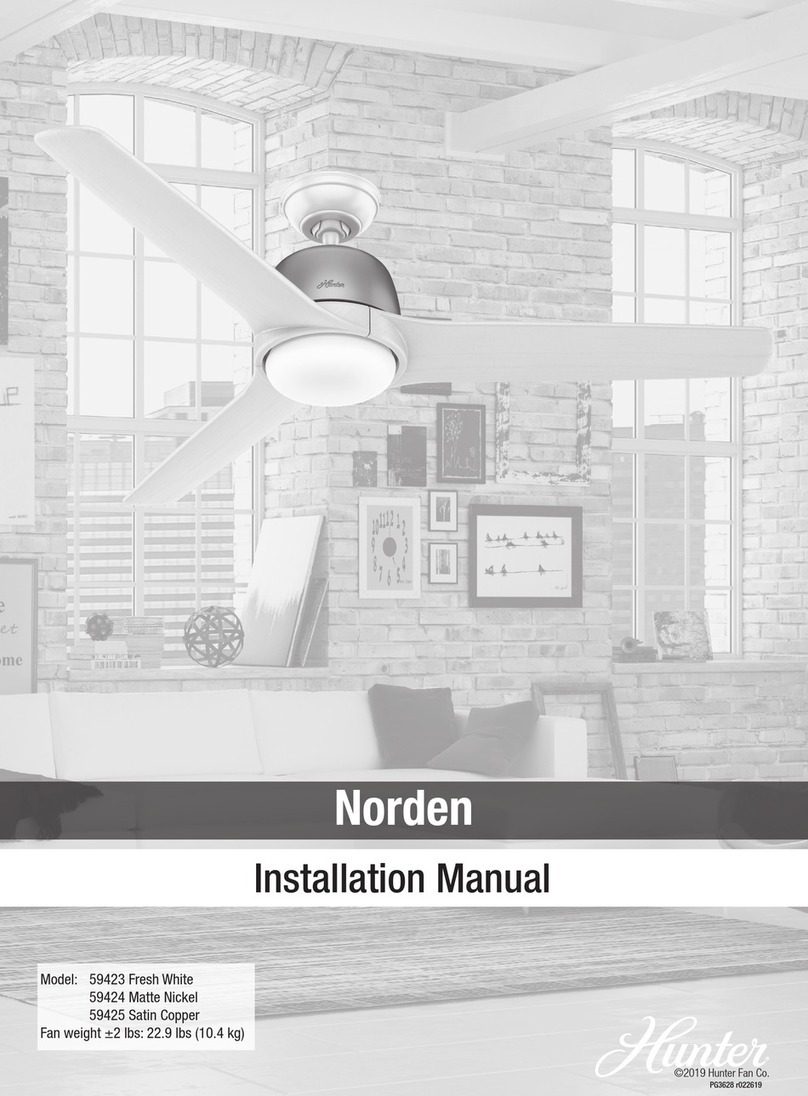
Hunter
Hunter Norden installation manual

Craftmade
Craftmade Copeland CN52 installation guide

Broan
Broan SOLITAIRE ULTRA-SILENT S50U quick start guide

AERMEC
AERMEC VEC20I Use and maintenance manual

villavent
villavent VR-400 EV User and maintenance instructions
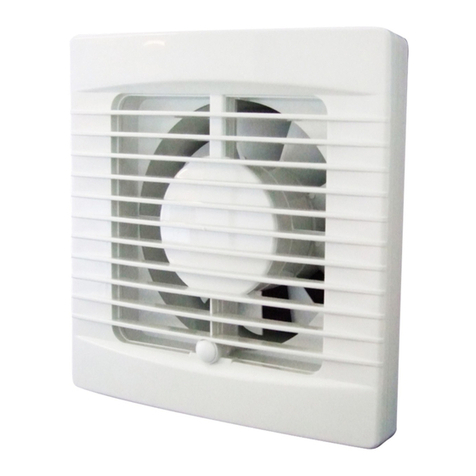
Manrose
Manrose Classic Series installation instructions

